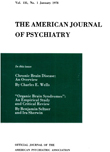THE DEVELOPMENT OF INTERCURRENT DISEASE AND INJURY IN THE TRANQUILIZED PSYCHIATRIC PATIENT
Abstract
This study indicated a direct, statistically significant association between tranquilization of hospitalized psychiatric patients aged 55 and older and the development of physical illness or injury. This was not demonstrated for patients of 54 and younger. Dosage or drug derivative could not be related to the development of illness nor could physical diagnosis be related to tranquilization. The data did suggest that tranquilization may be less compatible with the chronic brain syndrome than with other psychiatric conditons. We conclude that tranquilization of the psychiatric patient over 55 is associated with the subsequent development of nonfatal disease or injury of sufficient severity to warrant infirmary admission.
Access content
To read the fulltext, please use one of the options below to sign in or purchase access.- Personal login
- Institutional Login
- Sign in via OpenAthens
- Register for access
-
Please login/register if you wish to pair your device and check access availability.
Not a subscriber?
PsychiatryOnline subscription options offer access to the DSM-5 library, books, journals, CME, and patient resources. This all-in-one virtual library provides psychiatrists and mental health professionals with key resources for diagnosis, treatment, research, and professional development.
Need more help? PsychiatryOnline Customer Service may be reached by emailing [email protected] or by calling 800-368-5777 (in the U.S.) or 703-907-7322 (outside the U.S.).



